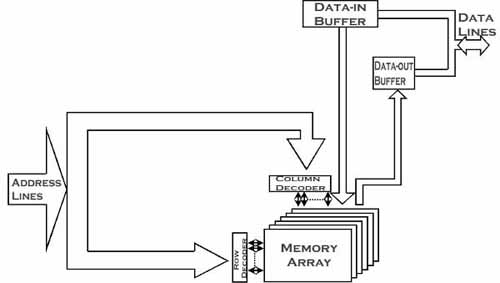RAMCHECK PLUS
RAMCHECK
RAMCHECK DDR
RAMCHECK Adapters
PC Communication
Product FAQ
SIMCHECK II Line
SIMCHECK II LT PLUS
Refurbished LT PLUS
SIMCHECK II Adapters
Original SIMCHECK Tester
Which System Is For Me?
Why Buy From Us?
Why Test Memory?
Int'l Distributors
How to Purchase
Free Newsletter
Tech Support
Service & Upgrades
Manuals
Software Downloads
FAQ
Site Map
Home
Contact us at
(281) 879-6226
sales@innoventions.com
DRAM (Dynamic Random-Access Memory) is the silicon-based medium that is used for the temporary storage of electronic information in modern personal computers and mainframes.
DRAM components are made of numerous cells, or storage locations, combining a capacitor and a transistor that hold either an active or an inactive state. Each DRAM cell is referred to as a Bit (binary digit), usually in reference to the smallest amount of information that a computer can work with. The DRAM's cell holds a value of '1' (active state), when it holds a charge beyond a certain level. It holds a value of '0' (inactive state) when the charge is below a certain level. Due to the nature of a capacitor, it is necessary to recharge/refresh the state in which the cell exists. The capacitor loses its charge over time, resulting in the loss of information.
DRAM cells are combined into a large array. The array is used to store vast amounts of information that is translated binarily by computers. The DRAM elements are arranged in specific groups organized in Rows and Columns, with each cell having an Address Location (specific Row and Column).

All cells may be accessed (read/write) by specifying the exact address at which the cell is located. A Byte is a group of eight of these specific DRAM cells. Modern computers use many of these cells assembled in memory modules containing Megabytes per module (106 bytes).
| DRAM | About SRAM |
| About DRAM | About Flash Memory |
| About EDO/FPM | About Embedded Memory |
| About SDRAM | About Optical Memory |
| About DDR | |
| About Rambus | |
| About FCRAM |
Other articles in this series:
How to repair RAM
Selecting a memory tester
Types of Memory
Memory Sources
How to test memory
Quality of Memory - Remarked versus marked, brand name vs no name
What is the SPD and how to program it
Evolution of memory
